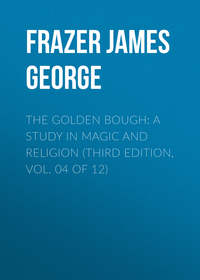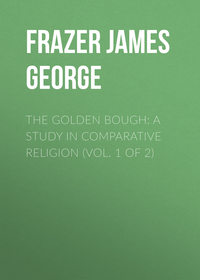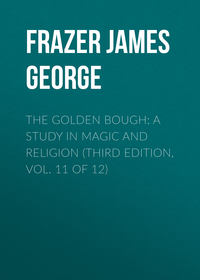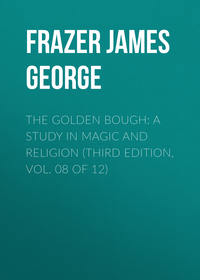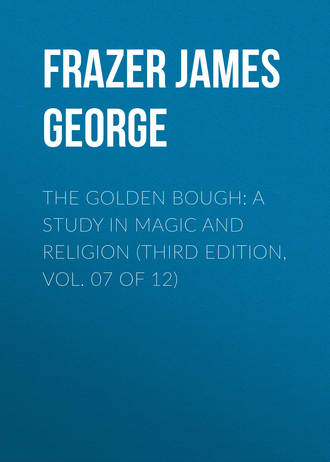
The Golden Bough: A Study in Magic and Religion (Third Edition, Vol. 07 of 12)
733
J. B. Labat, Relation historique de l'Ethiopie occidentale (Paris, 1732), i. 380.
734
John Adams, Sketches taken during Ten Voyages in Africa between the years 1786 and 1800 (London, n. d.), p. 25.
735
P. Bouche, La Côte des Esclaves (Paris, 1885), p. 132.
736
T. Arbousset et F. Daumas, Voyage d'exploration au Nord-est de la Colonie du Cap de Bonne-Espérance (Paris, 1842), pp. 117 sq. The custom has probably long been obsolete.
737
From information given me by my friend the Rev. John Roscoe, who resided for some time among the Wamegi and suppressed the sacrifice in 1886.
738
F. Blumentritt, “Das Stromgebiet des Rio Grande de Mindanao,” Petermanns Mitteilungen, xxxvii. (1891) p. 110.
739
A. Schadenberg, “Beiträge zur Kenntniss der im Innern Nordluzons lebenden Stämme,” Verhandlungen der Berliner Gesellschaft für Anthropologie, Ethnologie und Urgeschichte, 1888, p. (39) (bound with Zeitschrift für Ethnologie, xx. 1888).
740
Schadenberg, in Verhandlungen der Berliner Gesellschaft für Anthropologie, Ethnologie und Urgeschichte, 1889, p. (681) (bound with Zeitschrift für Ethnologie, xxi. 1889).
741
(Sir) J. G. Scott and J. P. Hardiman, Gazetteer of Upper Burma and the Shan States (Rangoon, 1900-1901), Part i. vol. i. pp. 493-509.
742
Col. R. G. Woodthorpe, “Some Account of the Shans and Hill Tribes of the States on the Mekong,” Journal of the Anthropological Institute, xxvi. (1897) p. 24.
743
For a general description of the country and the tribes see L. A. Waddell, “The Tribes of the Brahmaputra Valley,” Journal of the Asiatic Society of Bengal, lxix. Part iii. (Calcutta, 1901), pp. 1-127.
744
Miss G. M. Godden, “Naga and other Frontier Tribes of North-Eastern India,” Journal of the Anthropological Institute, xxvii. (1898) pp. 9 sq., 38 sq.
745
North Indian Notes and Queries, i. p. 4, § 15 (April 1891).
746
Panjab Notes and Queries, ii. pp. 127 sq., § 721 (May 1885).
747
Rev. P. Dehon, S.J., “Religion and Customs of the Uraons,” Memoirs of the Asiatic Society of Bengal, vol. i. No. 9 (Calcutta, 1906), pp. 141 sq.
748
Major S. C. Macpherson, Memorials of Service in India (London, 1865), pp. 113-131; Major-General John Campbell, Wild Tribes of Khondistan (London, 1864), pp. 52-58, etc. Compare Mgr. Neyret, Bishop of Vizagapatam, in Annales de la Propagation de la Foi, xxiii. (1851) pp. 402-404; E. Thurston, Ethnographic Notes on Southern India (Madras, 1906), pp. 510-519; id., Castes and Tribes of Southern India (Madras, 1909), iii. 371-385.
749
J. Campbell, op. cit. p. 56.
750
S. C. Macpherson, op. cit. pp. 115 sq.
751
S. C. Macpherson, op. cit. pp. 117 sq.; J. Campbell, op. cit. p. 112.
752
S. C. Macpherson, op. cit. pp. 117 sq.
753
S. C. Macpherson, op. cit. p. 118.
754
J. Campbell, op. cit. pp. 54 sq.
755
J. Campbell, op. cit. pp. 55, 112.
756
S. C. Macpherson, op. cit. p. 119; J. Campbell, op. cit. p. 113.
757
S. C. Macpherson, op. cit. p. 127. Instead of the branch of a green tree, Campbell mentions two strong planks or bamboos (p. 57) or a slit bamboo (p. 182).
758
J. Campbell, op. cit. pp. 56, 58, 120.
759
E. T. Dalton, Descriptive Ethnology of Bengal (Calcutta, 1872), p. 288, quoting Colonel Campbell's Report.
760
J. Campbell, op. cit. p. 126. The elephant represented the Earth Goddess herself, who was here conceived in elephant-form (Campbell, op. cit. pp. 51, 126). In the hill tracts of Goomsur she was represented in peacock-form, and the post to which the victim was bound bore the effigy of a peacock (Campbell, op. cit. p. 54).
761
S. C. Macpherson, op. cit. p. 130. In Mexico also the tears of the human victims were sometimes regarded as an omen of rain (B. de Sahagun, Histoire générale des Choses de la Nouvelle Espagne, traduite par D. Jourdanet et R. Simeon, Paris, 1880, bk. ii. ch. 20, p. 86).
762
E. T. Dalton, Descriptive Ethnology of Bengal, p. 288, referring to Colonel Campbell's Report.
763
S. C. Macpherson, op. cit. p. 129. Compare J. Campbell, op. cit. pp. 55, 58, 113, 121, 187.
764
J. Campbell, op. cit. p. 182.
765
S. C. Macpherson, op. cit. p. 128; E. T. Dalton, Descriptive Ethnology of Bengal, p. 288.
766
J. Campbell, op. cit. pp. 55, 182.
767
J. Campbell, op. cit. p. 187.
768
E. Thurston, Castes and Tribes of Southern India (Madras, 1909), iii. 381-385.
769
J. Campbell, op. cit. p. 112.
770
S. C. Macpherson, op. cit. p. 118.
771
Above, pp. 239, 240, 244.
772
Above, p. 134.
773
Above, pp. 134, 157 sqq.
774
Above, p. 223.
775
Above, p. 224.
776
Above, p. 170, with the references in note 1; Adonis, Attis, Osiris, Second Edition, pp. 195-197.
777
See above, p. 217.
778
Above, p. 224.
779
W. Mannhardt, Die Korndämonen, p. 5.
780
H. Pfannenschmid, Germanische Erntefeste (Hanover, 1878), p. 98.
781
Above, p. 217. It is not expressly said that he was wrapt in a sheaf.
782
Above, pp. 225 sq., 229 sq.
783
See The Dying God, pp. 160 sqq.
784
See Adonis, Attis, Osiris, Second Edition, pp. 231 sqq., 239 sq.
785
See The Magic Art and the Evolution of Kings, ii. 47 sqq.
786
I do not know when the corn is reaped in Phrygia; but the high upland character of the country makes it likely that harvest is later there than on the coasts of the Mediterranean.
787
See above, pp. 240 sqq.; and Adonis, Attis, Osiris, Second Edition, pp. 247-249. As to head-hunting in British Borneo see H. L. Roth, The Natives of Sarawak and British North Borneo (London, 1896), ii. 140 sqq.; in Central Celebes, see A. C. Kruijt, “Het koppensnellen der Toradja's van Midden-Celebes, en zijne Beteekenis,” Verslagen en Mededeelingen der koninklijke Akademie van Wetenschappen, Afdeelung Letterkunde, Vierde Reeks, iii. part 2 (Amsterdam, 1899), pp. 147-229; among the Igorot of Bontoc in Luzon, see A. E. Jenks, The Bontoc Igorot (Manilla, 1905), pp. 172 sqq.; among the Naga tribes of Assam, see Miss G. M. Godden, “Naga and other Frontier Tribes of North-East India”, Journal of the Anthropological Institute, xxvii. (1898) pp. 12-17. It must not, however, be thought that among these tribes the custom of procuring human heads is practised merely as a means to ensure the growth of the crops; it is apparently supposed to exert a salutary influence on the whole life of the people by providing them with guardian spirits in the shape of the ghosts of the men to whom in their lifetime the heads belonged. The Scythians of Central Europe in antiquity set great store on the heads of the enemies whom they had slain in war. See Herodotus, iv. 64 sq.
788
There are traces in Greece itself of an old custom of sacrificing human victims to promote the fertility of the earth. See Pausanias, vii. 19. 3 sq. compared with vii. 20. 1; id., viii. 53. 3; L. R. Farnell, The Cults of the Greek States, ii. (Oxford, 1896) p. 455; and The Dying God, pp. 161 sq.
789
Above, pp. 215 sq.
790
Above, p. 216.
791
Hesychius, s. v. Βῶρμον.
792
Apollodorus, Bibliotheca, ii. 6. 3.
793
The scurrilities exchanged both in ancient and modern times between vine-dressers, vintagers, and passers-by seem to belong to a different category. See W. Mannhardt, Mythologische Forschungen, pp. 53 sq.
794
See Adonis, Attis, Osiris, Second Edition, pp. 188 sqq.
795
Above, pp. 236 sq., 240, 243, 244, 248 sq.
796
The probable correspondence of the months, which supplies so welcome a confirmation of the conjecture in the text, was pointed out to me by my friend W. Robertson Smith, who furnished me with the following note: “In the Syro-Macedonian calendar Lous represents Ab, not Tammuz. Was it different in Babylon? I think it was, and one month different, at least in the early times of the Greek monarchy in Asia. For we know from a Babylonian observation in the Almagest (Ideler, i. 396) that in 229 b. c. Xanthicus began on February 26. It was therefore the month before the equinoctial moon, not Nisan but Adar, and consequently Lous answered to the lunar month Tammuz.”
797
Above, p. 215.
798
Apollodorus, Bibliotheca, ii. 5. 11; Scholiast on Apollonius Rhodius, Argon. iv. 1396; Plutarch, Parall. 38. Herodotus (ii. 45) discredits the idea that the Egyptians ever offered human sacrifices. But his authority is not to be weighed against that of Manetho (Plutarch, Isis et Osiris, 73), who affirms that they did. See further Dr. E. A. Wallis Budge, Osiris and the Egyptian Resurrection (London and New York, 1911), i. 210 sqq., who says (pp. 210, 212): “There is abundant proof for the statement that the Egyptians offered up sacrifices of human beings, and that, in common with many African tribes at the present day, their customs in dealing with vanquished enemies were bloodthirsty and savage… The passages from Egyptian works quoted earlier in this chapter prove that human sacrifices were offered up at Heliopolis as well as at Tetu, or Busiris, and the rumour of such sacrifices has found expression in the works of Greek writers.”
799
E. Meyer, Geschichte des Altertums, i. (Stuttgart, 1884), § 57, p. 68.
800
E. Meyer, Geschichte des Altertums,2 i. 2 (Stuttgart and Berlin, 1909), p. 97; G. Maspero, Histoire Ancienne des Peuples de l'Orient Classique, Les Origines (Paris, 1895), pp. 129 sqq. Both these eminent historians have abandoned their former theory that Osiris was the Sun-god. Professor E. Meyer now speaks of Osiris as “the great vegetation god” and, on the same page, as “an earth-god” (op. cit. i. 2. p. 70). I am happy to find the view of the nature of Osiris, which I advocated many years ago, supported by the authority of so distinguished an Oriental scholar. Dr. E. A. Wallis Budge holds that Busiris was the oldest shrine of Osiris in the north of Egypt, but that it was less ancient than his shrine at Abydos in the south. See E. A. Wallis Budge, Osiris and the Egyptian Resurrection (London and New York, 1911), ii. 1.
801
Diodorus Siculus, i. 88; Plutarch, Isis et Osiris, 73, compare 30, 33.
802
Margaret A. Murray, The Osireion at Abydos (London, 1904), p. 30, referring to Mariette, Dendereh, iv. plates xxxi., lvi., and lxxxi. The passage of Diodorus Siculus referred to is i. 62. 4. As to masks of animals worn by Egyptian men and women in religious rites see The Magic Art and the Evolution of Kings, ii. 133; The Dying God, p. 72.
803
Above, pp. 237 sq., 240, 251.
804
E. J. Payne, History of the New World called America, i. (Oxford, 1892) p. 422.
805
Brasseur de Bourbourg, Histoire des Nations civilisées du Mexique et de l'Amérique Centrale (Paris, 1857-1859), iii. 535.
806
Festus, s. v. Catularia, p. 45 ed. C. O. Müller. Compare id., s. v. Rutilae canes, p. 285; Columella, De re rustica, x. 342 sq.; Ovid, Fasti, iv. 905 sqq.; Pliny, Nat. Hist. xviii. 14.
807
D. Chwolsohn, Die Ssabier und der Ssabismus (St. Petersburg, 1856), ii. 388 sq. Compare ibid., pp. 384 sq., 386 sq., 391, 393, 395, 397. For other instances of the assimilation of the victim to the god, see H. Oldenberg, Die Religion des Veda (Berlin, 1894), pp. 77 sq., 357-359.
808
Above, pp. 240, 249.
809
Above, pp. 149 sq., 237 sq., 239.
810
Plutarch, Isis et Osiris, 18.
811
See above, p. 248; and compare Adonis, Attis, Osiris, Second Edition, pp. 331 sqq.
812
See Adonis, Attis, Osiris, Second Edition, p. 323.
813
Plutarch, Isis et Osiris, 22, 30, 31, 33, 73.
814
Sir J. G. Wilkinson, Manners and Customs of the Ancient Egyptians (ed. 1878), iii. 81.
815
Pausanias, i. 22. 3, viii. 5. 8, viii. 42. i.
816
Cornutus, Theologiae Graecae Compendium, 28. See above, p. 42.
817
W. Hone, Every-day Book (London, n. d.), ii. coll. 1170 sq.
818
Miss C. S. Burne and Miss G. F. Jackson, Shropshire Folk-lore (London, 1883), pp. 372 sq., referring to Mrs. Bray's Traditions of Devon, i. 330.
819
W. Hone, op. cit. ii. 1172.
820
The Rev. Sydney Cooper, of 80 Gloucester Street, Cirencester, wrote to me (4th February 1893) that his wife remembers the “neck” being kept on the mantelpiece of the parlour in a Cornish farmhouse; it generally stayed there throughout the year.
821
“Old Harvest Customs in Devon and Cornwall,” Folk-lore, i. (1890) p. 280.
822
Ibid.
823
Frances Hoggan, M.D., “The Neck Feast,” Folk-lore, iv. (1893) p. 123. In Pembrokeshire the last sheaf of corn seems to have been commonly known as “the Hag” (wrach) rather than as “the Neck.” See above, pp. 142-144.
824
J. Brand, Popular Antiquities, ii. 20 (Bohn's edition); Miss C. S. Burne and Miss G. F. Jackson, Shropshire Folk-lore, p. 371.
825
Burne and Jackson, l. c.
826
W. Mannhardt, Mythologische Forschungen, p. 185.
827
See above, p. 158.
828
W. Mannhardt, Mythologische Forschungen, p. 185.
829
Ibid.
830
Revue des Traditions populaires, ii. (1887) p. 500.
831
Above, p. 150.
832
E. Meier, in Zeitschrift für deutsche Mythologie und Sittenkunde, i. (1853) pp. 170-173; U. Jahn, Die deutschen Opfergebräuche bei Ackerbau und Viehzucht (Breslau, 1884), pp. 166-169; H. Pfannenschmid, Germanische Erntefeste (Hanover, 1878), pp. 104 sq.; A. Kuhn, Sagen, Gebräuche und Märchen aus Westfalen (Leipsic, 1859), ii. pp. 177 sq., §§ 491, 492; A. Kuhn und W. Schwartz, Norddeutsche Sagen, Märchen und Gebräuche (Leipsic, 1848), p. 395), § 97; K. Lynker, Deutsche Sagen und Sitten in hessischen Gauen (Cassel and Göttingen, 1860), p. 256, § 340.
833
W. Mannhardt, Die Korndämonen (Berlin, 1868), pp. 1-6.
834
W. Mannhardt, Roggenwolf und Roggenhund2 (Danzig, 1866), pp. 6 sqq.; id., Antike Wald- und Feldkulte (Berlin, 1877), pp. 318 sq.; id., Mythologische Forschungen, p. 103; A. Witzchel, Sagen, Sitten und Gebräuche aus Thüringen (Vienna, 1878), p. 213; O. Hartung, “Zur Volkskunde aus Anhalt,” Zeitschrift des Vereins für Volkskunde, vii. (1897) p. 150; W. Müller, Beiträge zur Volkskunde der Deutschen in Mähren (Vienna and Olmütz, 1893), p. 327; P. Drechsler, Sitte, Brauch und Volksglaube in Schlesien (Leipsic, 1903-1906), ii, 60.
835
W. Mannhardt, Roggenwolf und Roggenhund,2 pp. 10 sqq.; id., Antike Wald- und Feldkulte, p. 319.
836
W. Mannhardt, Roggenwolf und Roggenhund,2 pp. 14 sq.
837
W. Mannhardt, Mythologische Forschungen, p. 104; P. Drechsler, Sitte, Brauch und Volksglaube in Schlesien, ii. 64.
838
W. Mannhardt, Mythologische Forschungen, p. 104.
839
Ibid. pp. 104 sq. On the Harvest-May, see The Magic Art and the Evolution of Kings, ii. 47 sq.
840
L. F. Sauvé, Folk-lore des Hautes-Vosges (Paris, 1889), p. 191.
841
W. Mannhardt, Mythologische Forschungen, p. 105.
842
Ibid. p. 30.
843
Ibid. pp. 30, 105.
844
Ibid. pp. 105 sq.
845
P. Drechsler, Sitte, Brauch und Volksglaube in Schlesien (Leipsic, 1903-1906), ii. 64.
846
W. Mannhardt, Roggenwolf und Roggenhund,2 pp. 33, 39; K. Bartsch, Sagen, Märchen und Gebräuche aus Meklenburg (Vienna, 1879-1880), ii. p. 309, § 1496, p. 310, §§ 1497, 1498.
847
W. Mannhardt, Antike Wald- und Feldkulte, p. 320.
848
W. Mannhardt, Roggenwolf und Roggenhund,2 p. 33.
849
W. Mannhardt, Roggenwolf und Roggenhund,2 pp. 33 sq.; K. Bartsch, op. cit. ii. p. 309, § 1496, p. 310, §§ 1497, 1500, 1501.
850
W. Mannhardt, Roggenwolf und Roggenhund,2 pp. 33, 34.
851
W. Mannhardt, Roggenwolf und Roggenhund,2 p. 38; id., Antike Wald- und Feldkulte, p. 320.
852
W. Mannhardt, Roggenwolf und Roggenhund,2 pp. 34 sq.
853
K. Bartsch, op. cit. ii. p. 311, § 1505.
854
W. Mannhardt, Roggenwolf und Roggenhund,2 pp. 35-37; K. Bartsch, op. cit. ii. p. 309, § 1496, p. 310, §§ 1499, 1501, p. 311, §§ 1506, 1507.
855
W. Mannhardt, Antike Wald- und Feldkulte, p. 321.
856
Ibid. pp. 321 sq.
857
Ibid. p. 320.
858
Ibid. pp. 320 sq.
859
Ibid. p. 322.
860
Ibid. p. 323.
861
W. Mannhardt, Die Korndämonen, p. 13.
862
W. Mannhardt, l. c.; J. H. Schmitz, Sitten und Sagen, Lieder, Sprüchwörter und Rathsel des Eifler Volkes (Treves, 1856-1858), i. 95; A. Kuhn und W. Schwartz, Norddeutsche Sagen, Märchen und Gebräuche (Leipsic, 1848), p. 398.
863
G. A. Heinrich, Agrarische Sitten und Gebräuche unter den Sachsen Siebenbürgens (Hermannstadt, 1880), p. 21.
864
W. Mannhardt, Die Korndämonen, p. 13. Compare A. Kuhn and W. Schwartz, l. c.
865
K. Haupt, Sagenbuch der Lausitz (Leipsic, 1862-1863), i. p. 232, No. 277 note.
866
W. Mannhardt, Die Korndämonen, p. 13.
867
A. Witzschel, Sagen, Sitten und Gebräuche aus Thüringen (Vienna, 1878), p. 220.
868
W. Mannhardt, Die Korndämonen, pp. 13 sq.; J. H. Schmitz, Sitten und Sagen, Lieder, Sprüchwörter und Räthsel des Eifler Volkes (Treves, 1856-1858), i. 95; A. Kuhn, Sagen, Gebräuche und Märchen aus Westfalen (Leipsic, 1859), ii. 180 sq.; H. Pfannenschmid, Germanische Erntefeste (Hanover, 1878), p. 110.
869
W. Mannhardt, Die Korndämonen, p. 14; H. Pfannenschmid, op. cit. pp. 111, 419 sq.
870
W. Mannhardt, Die Korndämonen, p. 15. So in Shropshire, where the corn-spirit is conceived in the form of a gander (see above, p. 268), the expression for overthrowing a load at harvest is “to lose the goose,” and the penalty used to be the loss of the goose at the harvest-supper (C. S. Burne and G. F. Jackson, Shropshire Folk-lore, London, 1883, p. 375); and in some parts of England the harvest-supper was called the Harvest Gosling, or the Inning Goose (J. Brand, Popular Antiquities, ii. 23, 26, Bohn's edition).
871
W. Mannhardt, Die Korndämonen, p. 14.
872
Ibid. p. 15.
873
W. Mannhardt, Mythologische Forschungen, p. 30.
874
W. Mannhardt, Die Korndämonen, p. 15.


